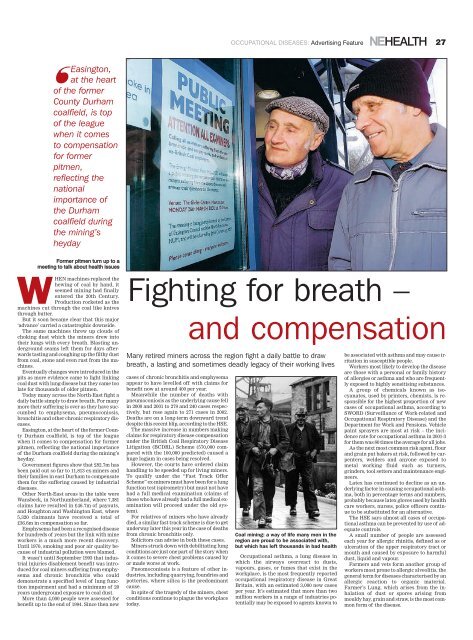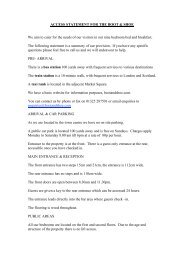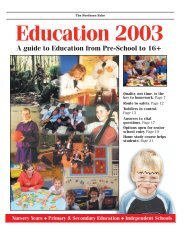SPORTS INJURY How to tackle it EXERCISE The power of Pilates ...
SPORTS INJURY How to tackle it EXERCISE The power of Pilates ...
SPORTS INJURY How to tackle it EXERCISE The power of Pilates ...
- No tags were found...
You also want an ePaper? Increase the reach of your titles
YUMPU automatically turns print PDFs into web optimized ePapers that Google loves.
OCCUPATIONAL DISEASES: Advertising FeatureN E HEALTH27❛ Easing<strong>to</strong>n,at the hear<strong>to</strong>f the formerCounty Durhamcoalfield, is <strong>to</strong>p<strong>of</strong> the leaguewhen <strong>it</strong> comes<strong>to</strong> compensationfor formerp<strong>it</strong>men,reflecting thenationalimportance <strong>of</strong>the Durhamcoalfield duringthe mining’sheydayF o r m e r p <strong>it</strong> m e n t u r n u p t o am e e t in g t o t a lk a b o u t h e a lt h is s u e sWHEN machines replaced thehewing <strong>of</strong> coal by hand, <strong>it</strong>seemed mining had finallyentered the 20th Century.Production rocketed as themachines cut through the coal like knivesthrough butter.But <strong>it</strong> soon became clear that this major‘advance’ carried a catastrophic downside.<strong>The</strong> same machines threw up clouds <strong>of</strong>choking dust which the miners drew in<strong>to</strong>their lungs w<strong>it</strong>h every breath. Blasting undergroundseams left them for days afterwardstasting and coughing up the filthy dustfrom coal, s<strong>to</strong>ne and even rust from the machines.Eventually changes were introduced in thep<strong>it</strong>s as more evidence came <strong>to</strong> light linkingcoal dust w<strong>it</strong>h lung disease but they came <strong>to</strong>olate for thousands <strong>of</strong> older p<strong>it</strong>men.Today many across the North-East fight adaily battle simply <strong>to</strong> draw breath. For manymore their suffering is over as they have succumbed<strong>to</strong> emphysema, pneumoconiosis,bronch<strong>it</strong>is and other chronic respira<strong>to</strong>ry diseases.Easing<strong>to</strong>n, at the heart <strong>of</strong> the former CountyDurham coalfield, is <strong>to</strong>p <strong>of</strong> the leaguewhen <strong>it</strong> comes <strong>to</strong> compensation for formerp<strong>it</strong>men, reflecting the national importance<strong>of</strong> the Durham coalfield during the mining’sheyday.Government figures show that £82.7m hasbeen paid out so far <strong>to</strong> 11,813 ex-miners andtheir families in east Durham <strong>to</strong> compensatethem for the suffering caused by industrialdiseases.Other North-East areas in the table wereWansbeck, in Northumberland, where 7,381claims have resulted in £46.7m <strong>of</strong> payouts,and Hough<strong>to</strong>n and Washing<strong>to</strong>n East, where5,320 claimants have received a <strong>to</strong>tal <strong>of</strong>£36.6m in compensation so far.Emphysema had been a recognised diseasefor hundreds <strong>of</strong> years but the link w<strong>it</strong>h mineworkers is a much more recent discovery.Until 1970, smoking and poor air qual<strong>it</strong>y because<strong>of</strong> industrial pollution were blamed.It wasn’t until September 1993 that industrialinjuries disablement benef<strong>it</strong> was introducedfor coal miners suffering from emphysemaand chronic bronch<strong>it</strong>is who coulddemonstrate a specified level <strong>of</strong> lung functionimpairment and had a minimum <strong>of</strong> 20years underground exposure <strong>to</strong> coal dust.More than 4,000 people were assessed forbenef<strong>it</strong> up <strong>to</strong> the end <strong>of</strong> 1994. Since then newFighting for breath –Many retired miners across the region fight a daily battle <strong>to</strong> drawbreath, a lasting and sometimes deadly legacy <strong>of</strong> their working livescases <strong>of</strong> chronic bronch<strong>it</strong>is and emphysemaappear <strong>to</strong> have levelled <strong>of</strong>f w<strong>it</strong>h claims forbenef<strong>it</strong> now at around 400 per year.Meanwhile the number <strong>of</strong> deaths w<strong>it</strong>hpneumoconiosis as the underlying cause fellin 2000 and 2001 <strong>to</strong> 279 and 240 cases respectively,but rose again <strong>to</strong> 271 cases in 2002.Deaths are on a long-term downward trenddesp<strong>it</strong>e this recent blip, according <strong>to</strong> the HSE.<strong>The</strong> massive increase in numbers makingclaims for respira<strong>to</strong>ry disease compensationunder the Br<strong>it</strong>ish Coal Respira<strong>to</strong>ry DiseaseL<strong>it</strong>igation (BCDRL) Scheme (570,000 comparedw<strong>it</strong>h the 100,000 predicted) caused ahuge logjam in cases being resolved.<strong>How</strong>ever, the courts have ordered claimhandling <strong>to</strong> be speeded up for living miners.To qualify under the “Fast Track OfferScheme” ex-miners must have been for a lungfunction test (spirometry) but must not havehad a full medical examination (claims <strong>of</strong>those who have already had a full medical examinationwill proceed under the old system).For relatives <strong>of</strong> miners who have alreadydied, a similar fast track scheme is due <strong>to</strong> getunderway later this year in the case <strong>of</strong> deathsfrom chronic bronch<strong>it</strong>is only.Solici<strong>to</strong>rs can advise in both these cases.Miners struck down w<strong>it</strong>h debil<strong>it</strong>ating lungcond<strong>it</strong>ions are just one part <strong>of</strong> the s<strong>to</strong>ry when<strong>it</strong> comes <strong>to</strong> severe chest problems caused byor made worse at work.Pneomoconiosis is a feature <strong>of</strong> other industries,including quarrying, foundries andpotteries, where silica is the predominantcause.In sp<strong>it</strong>e <strong>of</strong> the tragedy <strong>of</strong> the miners, chestcond<strong>it</strong>ions continue <strong>to</strong> plague the workplace<strong>to</strong>day.and compensationCoal mining: a way <strong>of</strong> life many men in theregion are proud <strong>to</strong> be associated w<strong>it</strong>h,but which has left thousands in bad healthOccupational asthma, a lung disease inwhich the airways overreact <strong>to</strong> dusts,vapours, gases, or fumes that exist in theworkplace, is the most frequently reportedoccupational respira<strong>to</strong>ry disease in GreatBr<strong>it</strong>ain, w<strong>it</strong>h an estimated 3,000 new casesper year. It’s estimated that more than twomillion workers in a range <strong>of</strong> industries potentiallymay be exposed <strong>to</strong> agents known <strong>to</strong>be associated w<strong>it</strong>h asthma and may cause irr<strong>it</strong>ationin susceptible people.Workers most likely <strong>to</strong> develop the diseaseare those w<strong>it</strong>h a personal or family his<strong>to</strong>ry<strong>of</strong> allergies or asthma and who are frequentlyexposed <strong>to</strong> highly sens<strong>it</strong>ising substances.A group <strong>of</strong> chemicals known as isocyanates,used by printers, chemists, is responsiblefor the highest proportion <strong>of</strong> newcases <strong>of</strong> occupational asthma, according <strong>to</strong>SWORD (Surveillance <strong>of</strong> Work-related andOccupational Respira<strong>to</strong>ry Disease) and theDepartment for Work and Pensions. Vehiclepaint sprayers are most at risk – the incidencerate for occupational asthma in 2001-3for them was 80 times the average for all jobs.As the next most common risk agent, flourand grain put bakers at risk, followed by carpenters,welders and anyone exposed <strong>to</strong>metal working fluid such as turners,grinders, <strong>to</strong>ol setters and maintenance engineers.Latex has continued <strong>to</strong> decline as an underlyingfac<strong>to</strong>r in causing occupational asthma,both in percentage terms and numbers,probably because latex gloves used by healthcare workers, nurses, police <strong>of</strong>ficers continue<strong>to</strong> be subst<strong>it</strong>uted for an alternative.<strong>The</strong> HSE says almost all cases <strong>of</strong> occupationalasthma can be prevented by use <strong>of</strong> adequatecontrols.A small number <strong>of</strong> people are assessedeach year for allergic rhin<strong>it</strong>is, defined as orulceration <strong>of</strong> the upper respira<strong>to</strong>ry tract ormouth and caused by exposure <strong>to</strong> harmfuldust, liquid and vapour.Farmers and vets form another group <strong>of</strong>workers most prone <strong>to</strong> allergic alveol<strong>it</strong>is, thegeneral term for diseases characterised by anallergic reaction <strong>to</strong> organic material.Farmer’s Lung, which arises from the inhalation<strong>of</strong> dust or spores arising frommouldy hay, grain and straw, is the most commonform <strong>of</strong> the disease.
















